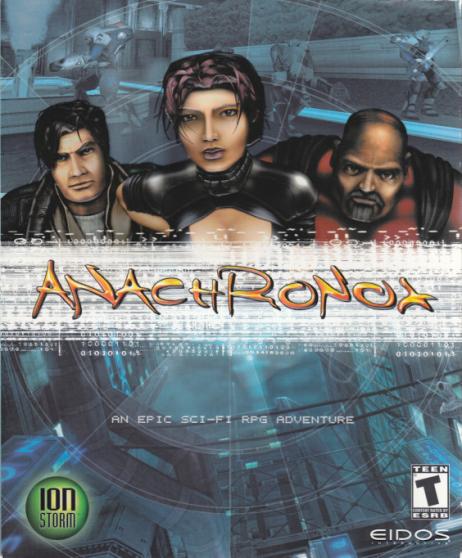Anachronox Review
-
Category: ReviewsHits: 7966

Article Index
Based on a futuristic, cyberpunk setting, Anachronox features the standby of such plots: the discovery of mysterious alien technology, named simply MysTech here, enables space travel and has intrigued scientists ever since. Anachronox itself is a planet, once home to some ancient alien race, and now the crime hub of the universe due to being well-positioned near the largest of the Senders, which make space travel possible. The player takes the role of Sly Boots, a failure of a private detective, just as he is thrown out of the window of his own office by a debt collector. Desperately seeking employment, you'll be hired to investigate some ruins for a pittance, where an unlucky set of circumstances will drive Boots to investigate further. You'll be joined on your journey by various characters, and will also have the company of your virtual secretary, Fatima, who is also the in-game cursor and manages various menus - a nice touch of immersion.
The game is played from the third perspective, using WASD to move and the cursor to interact with the environment. Consistent to its JRPG roots, Anachronox is a mostly linear game - it's hardly small, but there's very little freedom left for the player, short of not choosing to do a side quest. Speaking of side quests, there's a lot of them, and a lot of interesting encounters to be had too - despite its linearity, Anachronox still places a lot of emphasis on exploration. Unfortunately, this is somewhat of a double-edged sword, because the game is surprisingly stingy with giving out equipment (there's only a handful of weapons for each of the characters), and missing a piece could make the next leg of the journey much more difficult.
The side quests are usually interesting, though they as a rule involve a lot of running around; in addition, since Sly, as all good PIs, carries a camera with him, you'll often be tasked with photographing various objects or aliens. Unlike some more recent games, in Anachronox the "quest giver" is almost never obvious, so you'll be spending a lot of time talking to virtually everyone. Thankfully, most of the characters have something interesting to say and some are outright funny. This humor permeates the whole game, giving it its own unique charm and is probably the game's greatest strength. When you're not talking or wandering around, you'll be using one of your characters "world skills", which are implemented as easy minigames, to gather information or complete a task. Boots can pick locks and other characters will bring their own expertise into the mix (the most interesting, by far, will be the Yammer skill - Grumpos will incessantly talk to the "victim" about all sorts of unrelated things, which is often hilariously funny).
When diplomacy fails, or you're just exploring hostile areas, you'll be whisked into combat, which is real-time: your characters will spend varying amounts of time getting ready for their next action, which could be moving, using an item or a special ability, or just plain attacking an opponent. The combat arena is based on a grid, and characters can block ranged attacks against those behind them, which brings some depth to the system. Additionally, as the game progresses, you will gain access to magic (in the form of MysTech artifacts), which will further broaden the number of options available. Unfortunately, while you're choosing who to attack or where to move, time will still be flowing, which makes the combat somewhat hectic - the game really could use a pause function, or pseudo-realtime based combat, because as it stands currently, it requires a surprising amount of agility to do everything in time - on the other hand, the game is easy enough that only perfectionists will be bothered by this.
Character development is very streamlined, which is a bit disappointing. While there are a number of different stats, you can't choose which to improve - in addition, the stats themselves are only explained in a tutorial at the start, which you're bound to forget, so you'll spend some time wondering what each does. There's also very little loot management - the characters only have five equipable slots each, and weapons aren't interchangeable among them - though you will gather consumables and various miscellaneous objects as you progress. Characters' special attacks (the three not available at first) are gained by talking to the right people, as is the single world skill upgrade.
Anachronox is based on a heavily modified version of the Quake II engine, which wasn't too new then and is obviously outdated now. The art direction has a definite cyberpunk tone and is interesting, if a bit dark, but the low quality textures and low polygon counts will make this hard to notice. Unfortunately, the long, winding corridors combined with such textures can cause a mild headache, so you'll need some time to adjust, or will just have to take it slow at first. Sound ages considerably better, and is another strong suit of the game. The music is good, though not particularly memorable, while the voice-acting is excellent when it's present during the cutscenes.
Anachronox offers a console RPG experience, infused with an extraordinary amount of quality humor, and is worth playing for that reason alone; the actual gameplay is nothing revolutionary. If you do decide to play Anachronox, my only advice is to bear with it for a while - the old graphics and slow start might turn you off, but those who stick with it will be rewarded with some good laughs and a generally enjoyable time.


